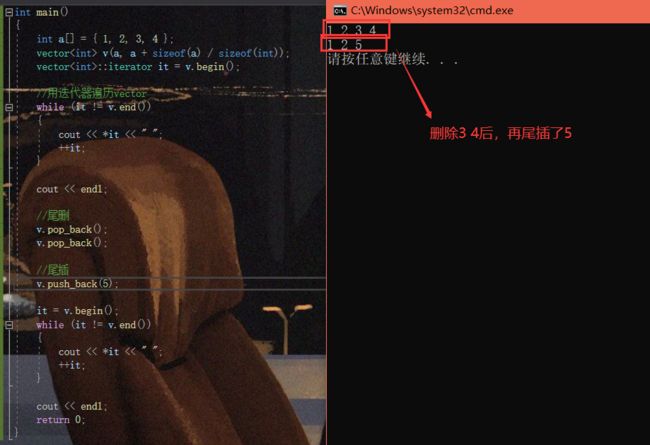C++vector
文章目录
- vector的介绍及使用
-
- vector的介绍
- vector的使用
-
- vector的定义
- vector的遍历
- vector iterator 的使用
- vector 空间增长问题
- vector 增删查改
- vector 迭代器失效问题
- vector 在OJ中的使用
- vector深度剖析及模拟实现
-
- 模拟实现vector
- 使用memcpy拷贝问题
- 对vector核心接口的测试
vector的介绍及使用
vector的介绍
vector的文档介绍
- vector是表示可变大小数组的序列容器。
- 就像数组一样,vector也采用的连续存储空间来存储元素。也就是意味着可以采用下标对vector的元素进行访问,和数组一样高效。但是又不像数组,它的大小是可以动态改变的,而且它的大小会被容器自
动处理。- 本质讲,vector使用动态分配数组来存储它的元素。当新元素插入时候,这个数组需要被重新分配大小
为了增加存储空间。其做法是,分配一个新的数组,然后将全部元素移到这个数组。就时间而言,这是一个相对代价高的任务,因为每当一个新的元素加入到容器的时候,vector并不会每次都重新分配大小。- vector分配空间策略:vector会分配一些额外的空间以适应可能的增长,因为存储空间比实际需要的存储空间更大。不同的库采用不同的策略权衡空间的使用和重新分配。但是无论如何,重新分配都应该是对数增长的间隔大小,以至于在末尾插入一个元素的时候是在常数时间的复杂度完成的。
- 因此,vector占用了更多的存储空间,为了获得管理存储空间的能力,并且以一种有效的方式动态增长。
- 与其它动态序列容器相比(deques, lists and forward_lists), vector在访问元素的时候更加高效,在末尾添加和删除元素相对高效。对于其它不在末尾的删除和插入操作,效率更低。比起lists和forward_lists统一的迭代器和引用更好。
vector的使用
vector的定义
| (constructor)构造函数声明 | 接口说明 |
|---|---|
| vector()(重点) | 无参构造 |
| vector(size_type n, const value_type& val = value_type()) | 构造并初始化n个val |
| vector (const vector& x); (重点) | 拷贝构造 |
| vector (InputIterator first, InputIterator last); | 使用迭代器进行初始化构造 |
// constructing vectors
#include vector的遍历
1.size()+operator[]
2.迭代器
3.范围for
vector iterator 的使用
| iterator的使用 | 接口说明 |
|---|---|
| begin + end(重点) | 获取第一个数据位置的iterator/const_iterator, 获取最后一个数据的下一个位置 的iterator/const_iterator |
| rbegin + rend | 获取最后一个数据位置的reverse_iterator,获取第一个数据前一个位置的 reverse_iterator |
#include vector 空间增长问题
| 容量空间 | 接口说明 |
|---|---|
| size | 获取数据个数 |
| capacity | 获取容量大小 |
| empty | 判断是否为空 |
| resize(重点) | 改变vector的size |
| reserve (重点) | 改变vector放入capacity |
- capacity的代码在vs和g++下分别运行会发现,vs下capacity是按1.5倍增长的,g++是按2倍增长的。
这个问题经常会考察,不要固化的认为,顺序表增容都是2倍,具体增长多少是根据具体的需求定义的。vs是PJ版本STL,g++是SGI版本STL。- reserve只负责开辟空间,如果确定知道需要用多少空间,reserve可以缓解vector增容的代价缺陷问
题。- resize在开空间的同时还会进行初始化,影响size
capacity
// vector::capacity
#include reserve
// vector::reserve
#include resize
// vector::resize
#include vector 增删查改
| vector增删查改 | 接口说明 |
|---|---|
| push_back | 尾插 |
| pop_back | 尾删 |
| find | 查找。(注意这个是算法模块实现,不是vector的成员接口) |
| insert | 在position之前插入val |
| erase | 删除position位置的数据 |
| swap | 交换两个vector的数据空间 |
| operator[] | 像数组一样访问 |
push_back和pop_back的使用
// push_back/pop_back
#include 结果:
find、insert、erase的使用
//insert,用迭代器插入
iterator insert (iterator position, const value_type& val);
//erase,用迭代器删除
iterator erase (iterator position);
//find
template <class InputIterator, class T>
//用迭代器遍历查找,返回的是所找元素的迭代器位置
InputIterator find (InputIterator first, InputIterator last, const T& val);
// find / insert / erase
#include 结果:
operator[]、swap的使用
// operator[]+index 和 C++11中vector的新式for+auto的遍历
// vector使用这两种遍历方式是比较便捷的。
#include 结果:
C++98下,最好使用vector的swap,全局的swap会涉及深浅拷贝,开销较大
C++11则都一样
vector 迭代器失效问题
迭代器的主要作用就是让算法能够不用关心底层数据结构,其底层实际就是一个指针,或者是对指针进行了封装,比如:vector的迭代器就是原生态指针T*。因此迭代器失效,实际就是迭代器底层对应指针所指向的空间被销毁了,而使用一块已经被释放的空间,造成的后果是程序崩溃(即如果继续使用已经失效的迭代器(程序可能会崩溃)
对于vector可能会导致其迭代器失效的操作有:
-
会引起其底层空间改变的操作,都有可能是迭代器失效,导致迭代器变成野指针。比如:resize、reserve、insert、assign、push_back等
#includeusing namespace std; #include int main() { vector<int> v{1,2,3,4,5,6}; auto it = v.begin(); // 将有效元素个数增加到100个,多出的位置使用8填充,操作期间底层会扩容 // v.resize(100, 8); // reserve的作用就是改变扩容大小但不改变有效元素个数,操作期间可能会引起底层容量改变 // v.reserve(100); // 插入元素期间,可能会引起扩容,而导致原空间被释放 // v.insert(v.begin(), 0); // v.push_back(8); // 给vector重新赋值,可能会引起底层容量改变 v.assign(100, 8); /* 出错原因:以上操作,都有可能会导致vector扩容,也就是说vector底层原理旧空间被释放掉, 而在打印时,it还使用的是释放之间的旧空间,在对it迭代器操作时,实际操作的是一块已经被释放的 空间,而引起代码运行时崩溃。 解决方式:在以上操作完成之后,如果想要继续通过迭代器操作vector中的元素,只需给it重新 赋值即可。 */ while(it != v.end()) { cout<< *it << " " ; ++it; } cout<<endl; return 0; } -
指定位置元素的删除操作–erase
#includeusing namespace std; #include int main() { int a[] = { 1, 2, 3, 4 }; vector<int> v(a, a + sizeof(a) / sizeof(int)); // 使用find查找3所在位置的iterator vector<int>::iterator pos = find(v.begin(), v.end(), 3); // 删除pos位置的数据,导致pos迭代器失效。 v.erase(pos); cout << *pos << endl; // 此处会导致非法访问 return 0; } erase删除pos位置元素后,pos位置之后的元素会往前搬移,没有导致底层空间的改变,理论上讲迭代器不应会失效,但是:如果pos刚好是最后一个元素,删完之后pos刚好是end的位置,而end位置是没有元素的,那么pos就失效了。因此删除vector中任意位置上元素时,vs就认为该位置迭代器失效了。
以下代码的功能是删除vector中所有的偶数
#includeusing namespace std; #include int main() { vector<int> v{ 1, 2, 3, 4 }; auto it = v.begin(); while (it != v.end()) { if (*it % 2 == 0) v.erase(it); ++it; } return 0; } 看一下结果:
vs2019下:

g++(Linux)下:

可以看到两个编译器都对其报了错误,而且是与内存访问相关的错误,为什么呢?
这里实际上就是一个迭代器失效的案例
解释:
vector中有元素{1,2,3,4},1不是偶数,所以不会删除,迭代器it向后走,指向2,2是偶数,所以删除2,此时迭代器还是向后走,我们的原意是想让it指向3,可是vector已经变成了{1,3,4},it指向的是第三个位置,所以指向了4,再删除4,vector变成了{1,3},it向后走,此时it已经不指向vector中的内容了,而v.end()指向的是3,所以it永远不会等于v.end(),也就是it会一直向后非法访问,直到访问到没有权限的位置,程序就异常结束了。
而vs是在删除2后,++it时出错的,++it会出错是因为VS编译器会在++的时候对it进行检查,如果有非法访问的行为则直接抛异常
我们在vecotr中加一个数字5,结果就不一样了:
vs下:

g++下:

可以看到g++下的编译通过了,vs还是抛出了异常,因为这是一种巧合的情况,刚好不会发生非法的内存访问,当删除4之后,it++指向了5,5不是偶数,于是不会被删除,it再++,it就到了v.end()的位置,结束循环。
而vs中仍然在同样的地方抛出了异常,是因为这种行为是不被允许的,可能会造成错误,于是vs就直接终止了程序。
那么怎么解决这种问题呢?
erase会返回删除位置的下一个位置的迭代器,我们用it接收这个值,更新it的位置,指向的刚好就是下一个元素的位置,就不会发生非法的访问了
//代码int main() { vector<int> v{ 1, 2, 3, 4 }; auto it = v.begin(); while (it != v.end()) { if (*it % 2 == 0) it = v.erase(it); else ++it; } return 0; }
总结:
迭代器失效解决办法:在使用前,对迭代器重新赋值即可
vector 在OJ中的使用
只出现一次的数字 - 力扣(LeetCode) (leetcode-cn.com)
杨辉三角 - 力扣(LeetCode) (leetcode-cn.com)
删除有序数组中的重复项 - 力扣(LeetCode) (leetcode-cn.com)
只出现一次的数字 II - 力扣(LeetCode) (leetcode-cn.com)
只出现一次的数字 III - 力扣(LeetCode) (leetcode-cn.com)
数组中出现次数超过一半的数字
电话号码的字母组合 - 力扣(LeetCode) (leetcode-cn.com)
连续子数组的最大和
vector深度剖析及模拟实现
start、finish和end_of_storage是vector的三个核心成员变量,这三个成员变量的意义如上图所示。他们的类型是迭代器
template<class T>
typedef T value_type;
typedef value_type* iterator;
private:
iterator _start;
iterator _finish;
iterator _end_of_storage;
模拟实现vector
#include& operator=(const vector& v)
{
delete[] _start;
_start = new T[v.capacity()];
memcpy(_start, v._start, v.size()*sizeof(T));
_finish = _start + v.size();
_endof_storage = _start + v.capacity();
return *this;
}*/
//现代写法
const vector<T>& operator=(vector<T> v)
{
swap(v);
return *this;
}
size_t size()const
{
return _finish - _start;
}
size_t capacity()const
{
return _endof_storage - _start;
}
bool empty()
{
return _start == _finish;
}
//增容
void reserve(size_t n)
{
if (n > capacity())
{
size_t sz = size();
T* tmp = new T[n];
if (_start)//当前vector不为空
{
for (size_t i = 0; i < size(); ++i)
{
tmp[i] = _start[i];
}
//不能用memcpy拷贝,memcpy是字节拷贝,属于浅拷贝,如果vector装的是string这样需要深拷贝的成员,就会生成野指针,也就是string的_str指向了一块被释放的空间(下面的_start被释放了)
/*memcpy(tmp, _start, sz * sizeof(T));*/
delete[] _start;
}
_start = tmp;
_finish = _start + sz;//用提前保存的sz而不是size接口,如果原vector是空的话,size()就是一个很大的值,就会造成非法访问
_endof_storage = _start + n;
}
}
void resize(size_t n, T val = T())
{
//判断增容
if (_finish == _endof_storage)
{
int newcapacity = 0 ? 4 : 2 * capacity();
resize(newcapacity);
}
//n
if (n < size())
{
_finish = _start + n;
}
else
{
//小于capacity
if (n < capacity())
{
while (n >= size())
{
*_finish = val;
_finish++;
}
}
else//大于capacity
{
//增容
reserve(n);
while (n >= size())
{
*_finish = val;
_finish++;
}
}
}
}
//尾插
void push_back(const T& x)
{
//判断增容
while (_finish == _endof_storage)
{
reserve(capacity() == 0 ? 4 : 2 * capacity());
}
*_finish = x;
++_finish;
}
//插入
iterator insert(iterator pos, T val)
{
//判断增容
if (_finish == _endof_storage)
{
//增容会有迭代器失效的隐患,所以要记录pos的相对位置
int len = pos - _start;
int newcapacity = capacity() == 0 ? 4 : 2 * capacity();
reserve(newcapacity);
pos = _start + len;
}
iterator it = _finish;
while (it > pos)
{
*it = *(it - 1);
--it;
}
*pos = val;
_finish++;
return pos + 1;
}
iterator erase(iterator pos)
{
assert(!empty());
iterator it = pos;
while (it < _finish - 1)
{
*it = *(it + 1);
++it;
}
_finish--;
return pos;
}
void pop_back()
{
assert(!empty());
--_finish;
}
//迭代器
iterator begin()
{
return _start;
}
iterator end()
{
return _finish;
}
//const迭代器
iterator begin()const
{
return _start;
}
iterator end()const
{
return _finish;
}
//operator[]
T& operator[](size_t pos)
{
assert(pos < size());
return *(_start + pos);
}
void print()const
{
ysj::vector<T>::const_iterator it = begin();
while (it != end())
{
std::cout << *it << " ";
++it;
}
std::cout << std::endl;
}
~vector()
{
delete[] _start;
_start = _finish = _endof_storage = nullptr;
}
private:
iterator _start;
iterator _finish;
iterator _endof_storage;
};
}
使用memcpy拷贝问题
假设模拟实现的vector中的reserve接口中,使用memcpy进行的拷贝,以下代码会发生什么问题?
int main()
{
ysj::vector<string> v;
v.push_back("1111");
v.push_back("2222");
v.push_back("3333");
return 0;
}
问题分析:
- memcpy是内存的二进制格式拷贝,将一段内存空间中内容原封不动的拷贝到另外一段内存空间中
- 如果拷贝的是自定义类型的元素,memcpy既高效又不会出错,但如果拷贝的是自定义类型元素,并且
自定义类型元素中涉及到资源管理时,就会出错,因为memcpy的拷贝实际是浅拷贝。



结论:如果对象中涉及到资源管理时,千万不能使用memcpy进行对象之间的拷贝,因为memcpy是
浅拷贝,否则可能会引起内存泄漏甚至程序崩溃。
对vector核心接口的测试
using namespace std;
// constructing vectors
void TestVector1()
{
// constructors used in the same order as described above:
ysj::vector<int> first; // empty vector of ints
ysj::vector<int> second(4, 100); // four ints with value 100
ysj::vector<int> third(second. begin(), second.end()); // iterating through second
ysj::vector<int> fourth(third); // a copy of third
// the iterator constructor can also be used to construct from arrays:
int myints[] = { 16, 2, 77, 29 };
ysj::vector<int> fifth(myints, myints + sizeof(myints) / sizeof(int));
std::cout << "The contents of fifth are:";
for (ysj::vector<int>::iterator it = fifth. begin(); it != fifth.end(); ++it)
std::cout << *it << " ";
std::cout << endl;
// 测试T是string时,拷贝问题
ysj::vector<string> strV;
strV.push_back("1111");
strV.push_back("2222");
strV.push_back("3333");
strV.push_back("4444");
for (size_t i = 0; i < strV.size(); ++i)
{
cout << strV[i] << " ";
}
cout << endl;
}
//vector iterator的使用
void PrintVector(const ysj::vector<int>& v)
{
// 使用const迭代器进行遍历打印
ysj::vector<int>::const_iterator it = v. begin();
while (it != v.end())
{
cout << *it << " ";
++it;
}
cout << endl;
}
void TestVector2()
{
// 使用push_back插入4个数据
ysj::vector<int> v;
v.push_back(1);
v.push_back(2);
v.push_back(3);
v.push_back(4);
PrintVector(v);
// 使用迭代器进行修改
auto it = v. begin();
while (it != v.end())
{
*it *= 2;
++it;
}
PrintVector(v);
// 这里可以看出C++11支持iterator及接口,就支持范围for
for (auto e : v)
cout << e << " ";
}
// find / insert / erase
void TestVector3()
{
int a[] = { 1, 2, 3, 4 };
ysj::vector<int> v(a, a + sizeof(a) / sizeof(a[0]));
// 使用find查找3所在位置的iterator
auto pos = find(v. begin(), v.end(), 3);
// 在pos位置之前插入30
v.insert(pos, 30);
PrintVector(v);
// 删除pos位置的数据
pos = find(v. begin(), v.end(), 3);
v.erase(pos);
PrintVector(v);
}
// iterator失效问题
void TestVector4()
{
int a[] = { 1, 2, 3, 4 };
ysj::vector<int> v(a, a + sizeof(a) / sizeof(a[0]));
// 删除pos位置的数据,导致pos迭代器失效
auto pos = find(v. begin(), v.end(), 3);
v.erase(pos);
cout << *pos << endl; // 此处会导致非法访问
// 在pos位置插入数据,导致pos迭代器失效。
// insert会导致迭代器失效,是因为insert可
// 能会导致增容,增容后pos还指向原来的空间,而原来的空间已经释放了。
pos = find(v. begin(), v.end(), 3);
v.insert(pos, 30);
cout << *pos << endl; // 此处会导致非法访问
// 实现删除v中的所有偶数
// 下面的程序会崩溃掉,如果是偶数,erase导致it失效
// 对失效的迭代器进行++it,会导致程序崩溃
auto it = v. begin();
/*while (it != v.end())
{
if (*it % 2 == 0)
v.erase(it);
++it;
}*/
// 以上程序要改成下面这样,erase会返回删除位置的下一个位置
cout << "删除前:";
PrintVector(v);
it = v. begin();
while (it != v.end())
{
if (*it % 2 == 0)
it = v.erase(it);
else
++it;
}
cout << "删除后:";
PrintVector(v);
}
int main()
{
//TestVector1();
//TestVector2();
//TestVector3();
TestVector4();
return 0;
}





